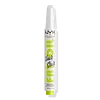What's inside
What's inside
 Key Ingredients
Key Ingredients

 Benefits
Benefits

 Concerns
Concerns

 Ingredients Side-by-side
Ingredients Side-by-side

Isododecane
EmollientDimethicone
EmollientTrimethylsiloxysilicate
EmollientPolybutene
Petrolatum
EmollientCyclohexasiloxane
EmollientKaolin
AbrasiveDisteardimonium Hectorite
StabilisingSilica Dimethyl Silylate
EmollientTocopherol
AntioxidantPersea Gratissima Oil
Skin ConditioningCyclopentasiloxane
EmollientGlyceryl Behenate/Eicosadioate
EmollientTin Oxide
AbrasivePropylene Carbonate
SolventCaprylyl Glycol
EmollientHexylene Glycol
EmulsifyingAroma
Phenoxyethanol
PreservativeMica
Cosmetic ColorantCI 77891
Cosmetic ColorantCI 77491
Cosmetic ColorantCI 77492
Cosmetic ColorantCI 77499
Cosmetic ColorantCI 42090
Cosmetic ColorantCI 75470
Cosmetic ColorantCI 15850
Cosmetic ColorantCI 45410
Cosmetic ColorantCI 73360
Cosmetic ColorantCI 45380
Cosmetic ColorantCI 17200
Cosmetic ColorantCI 19140
Cosmetic ColorantCI 15985
Cosmetic ColorantIsododecane, Dimethicone, Trimethylsiloxysilicate, Polybutene, Petrolatum, Cyclohexasiloxane, Kaolin, Disteardimonium Hectorite, Silica Dimethyl Silylate, Tocopherol, Persea Gratissima Oil, Cyclopentasiloxane, Glyceryl Behenate/Eicosadioate, Tin Oxide, Propylene Carbonate, Caprylyl Glycol, Hexylene Glycol, Aroma, Phenoxyethanol, Mica, CI 77891, CI 77491, CI 77492, CI 77499, CI 42090, CI 75470, CI 15850, CI 45410, CI 73360, CI 45380, CI 17200, CI 19140, CI 15985
Bis-Diglyceryl Polyacyladipate-2
EmollientPolyisobutene
Tridecyl Trimellitate
EmollientDiisostearyl Malate
EmollientPentaerythrityl Tetraisostearate
EmollientSynthetic Wax
AbrasivePolyglyceryl-2 Triisostearate
EmulsifyingPersea Gratissima Oil
Skin ConditioningRubus Chamaemorus Seed Oil
Skin ConditioningRubus Idaeus Seed Oil
EmollientTin Oxide
AbrasiveAroma
Synthetic Fluorphlogopite
Tocopheryl Acetate
AntioxidantPhenoxyethanol
PreservativeCI 15850
Cosmetic ColorantCI 77491
Cosmetic ColorantCI 77492
Cosmetic ColorantCI 77499
Cosmetic ColorantCI 77891
Cosmetic ColorantCI 19140
Cosmetic ColorantBenzyl Alcohol
PerfumingBis-Diglyceryl Polyacyladipate-2, Polyisobutene, Tridecyl Trimellitate, Diisostearyl Malate, Pentaerythrityl Tetraisostearate, Synthetic Wax, Polyglyceryl-2 Triisostearate, Persea Gratissima Oil, Rubus Chamaemorus Seed Oil, Rubus Idaeus Seed Oil, Tin Oxide, Aroma, Synthetic Fluorphlogopite, Tocopheryl Acetate, Phenoxyethanol, CI 15850, CI 77491, CI 77492, CI 77499, CI 77891, CI 19140, Benzyl Alcohol
 Reviews
Reviews

Ingredients Explained
These ingredients are found in both products.
Ingredients higher up in an ingredient list are typically present in a larger amount.
Aroma refers to an ingredient, or mixture of ingredients, that impart or mask a flavor.
The name is slightly confusing. This is because INCI associates aroma with flavor instead of smell.
Here is the official definition from the The International Cosmetic Ingredient Dictionary and Handbook:
“Aroma is a term for ingredient labeling used to identify that a product contains a material or combination of materials normally added to a cosmetic to produce or to mask a particular flavor.”
INCI shows the only purpose of aroma to be "flavouring".
However, due to regulation differences, some companies may use aroma in place of parfum.
In Canada, this ingredient only has to be listed in concentrations above 1%.
Learn more about AromaCi 15850 is the pigment color red. It is an azo dye and created synthetically.
Azo dyes need to be thoroughly purified before use. This allows them to be more stable and longer-lasting.
This ingredient is common in foundations, lipsticks, and blushes. This color is described as brown/orangey red.
It has many secondary names such as Red 6 and Red 7. According to a manufacturer, Red 6 usually contains aluminum.
Learn more about CI 15850CI 19140 is also known as Tartrazine. Tartrazine is a synthetic dye used in cosmetics, foods, and medicine to add a yellow color.
Tartrazine is created from petroleum and is water-soluble.
Some people may experience allergies from this dye, especially asthmatics and those with an aspirin intolerance.
Learn more about CI 19140Ci 77491 is also hydrated iron III oxide. It's sole purpose is to give a red/pink hue to products.
Iron III oxides are classified as inorganic chemicals for coloring.
Synthetically created Ci 77491 is considered safer than those naturally found. This is because the synthetically created version may contain less impurities. Iron oxides are generally non-toxic and non-allergenic.
Learn more about CI 77491Ci 77492 is also hydrated iron III oxide. It's sole purpose is to give a yellow hue to products.
Iron III oxides are classified as inorganic chemicals for coloring.
Synthetically created Ci 77492 is considered safer than those naturally found. This is because the synthetically created version may contain less impurities. Iron oxides are generally non-toxic and non-allergenic.
Learn more about CI 77492Ci 77499 is also hydrated iron III oxide. It is created from mixing red and black iron oxides. This helps give shades of darkness to a product.
Iron III oxides are classified as inorganic chemicals for coloring.
Ci 77891 is a white pigment from Titanium dioxide. It is naturally found in minerals such as rutile and ilmenite.
It's main function is to add a white color to cosmetics. It can also be mixed with other colors to create different shades.
Ci 77891 is commonly found in sunscreens due to its ability to block UV rays.
Learn more about CI 77891Persea Gratissima Oil is also known as avocado oil.
Avocado Oil has antioxidant properties. It is mostly made up of the glycerides of fatty acids. About 67% of these fatty acids is made up of oleic acid. Palmitic acid and linoleic acid are also present.
These fatty acids help hydrate and soften the skin. It may increase collagen content in the skin. Collagen helps keep your skin plump and firm. This ingredient helps reduce inflammation and has not shown to clog pores.
This ingredient may not be fungal-acne safe due to its high fatty acid content.
Avocados also have B vitamins, vitamin K, vitamin C, vitamin E, and potassium.
Learn more about Persea Gratissima OilPhenoxyethanol is a preservative that has germicide, antimicrobial, and aromatic properties. Studies show that phenoxyethanol can prevent microbial growth. By itself, it has a scent that is similar to that of a rose.
It's often used in formulations along with Caprylyl Glycol to preserve the shelf life of products.
Tin Oxide is an inorganic oxide used to add opacity and volume to a product. In nature, it is already found in mineral form. The main ore of tin is an opaque and shiny mineral called casseterite.
Tin Oxide helps remove translucency in a product, or make it more opaque. Besides adding opacity, tin oxide is used for bulking to add volume.